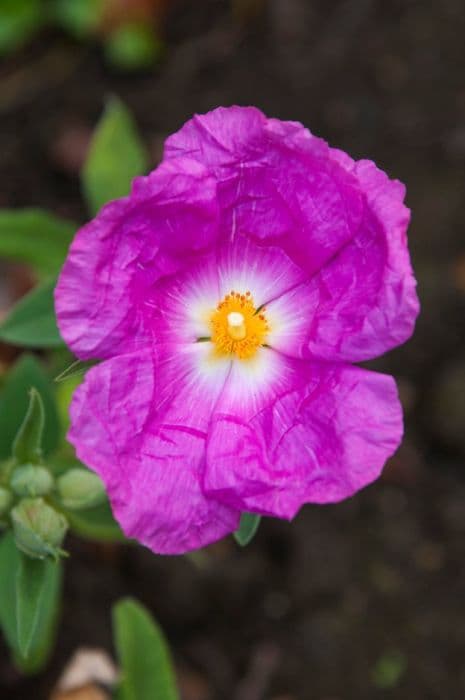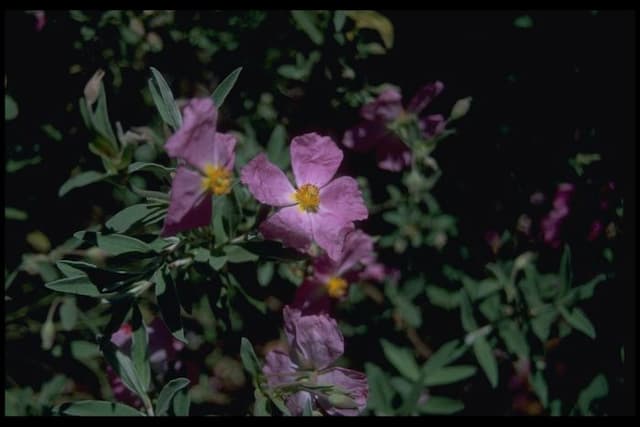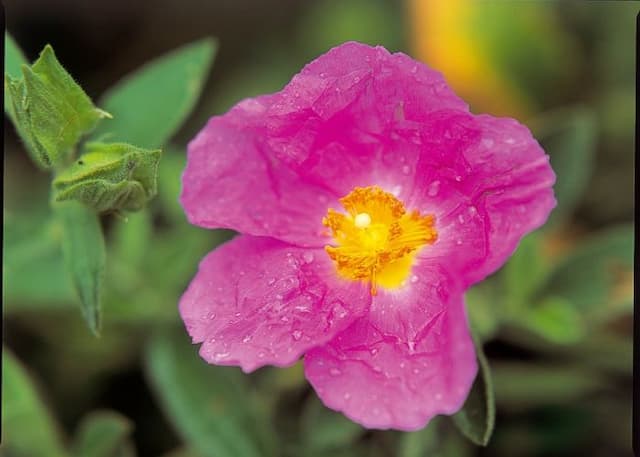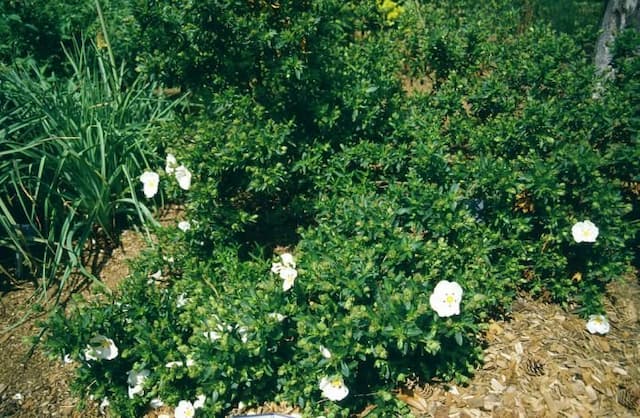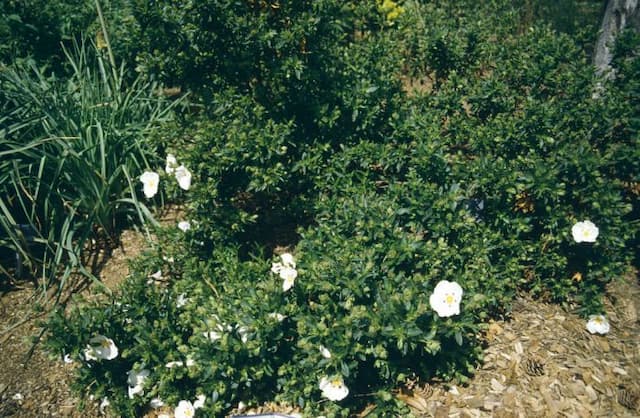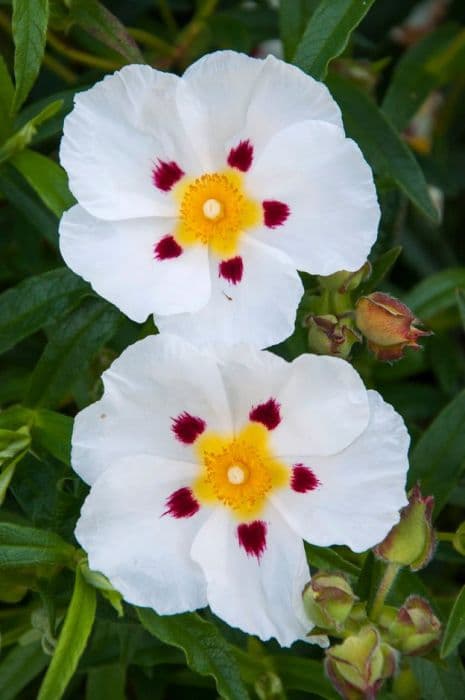Rock Rose Halimium calycinum
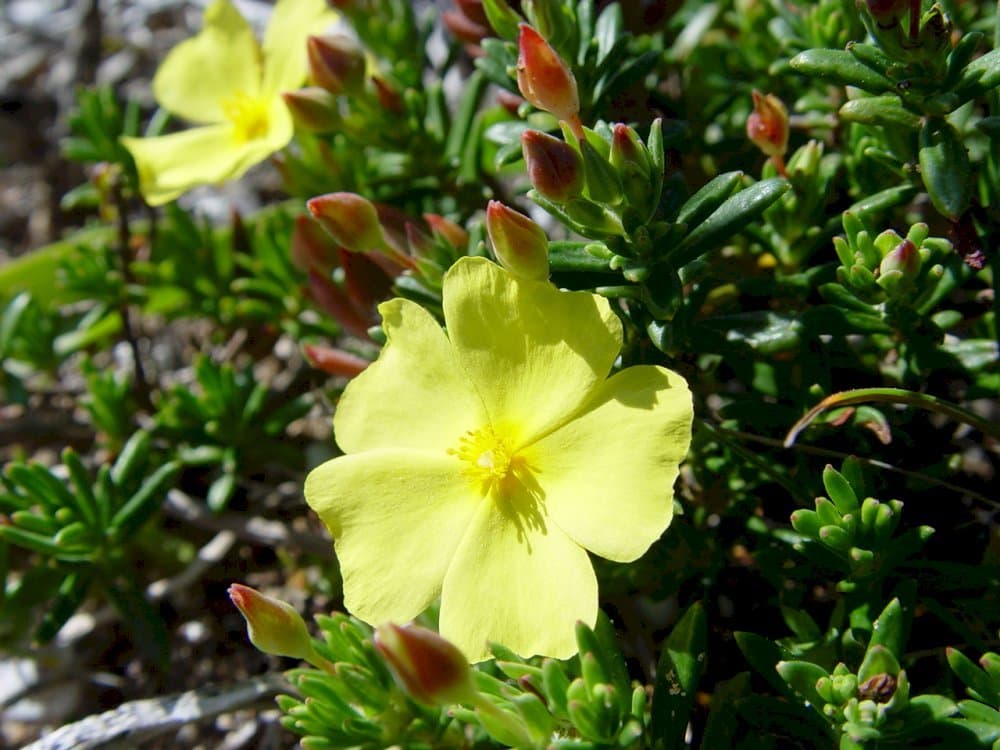
ABOUT
The plant commonly referred to as rock rose has an appealing aesthetic that draws attention in gardens and natural landscapes. It is characterized by its dense, sprawling growth habit, forming a low, bushy appearance with a profusion of branches. The leaves of the rock rose are small, evergreen, and typically have a grayish-green color, providing a beautiful contrast to the flowers and creating a backdrop that allows the blossoms to stand out even more. The most striking feature of the rock rose are its flowers, which are large, showy, and resemble those of the true roses, hence the common name. These blooms are often a bright yellow color, displaying a prominent central cluster of darker stamens that add to their ornamental value. The petals have a silky texture and can sometimes show a delicate pattern or a paler hue towards the margins. These attractive flowers are a major draw for pollinators such as bees and butterflies, which are enticed by both the vivid colors and the accessible pollen. Throughout its blooming period, the rock rose can become covered in such an abundance of flowers that the foliage almost disappears beneath the floral display. When not in bloom, the plant remains an evergreen presence in the landscape, with its foliage providing year-round interest. The overall form of the rock rose presents a natural, somewhat wild look, which can complement a variety of garden styles, especially those aiming for a Mediterranean or drought-tolerant theme.
About this plant
 Names
NamesFamily
Cistaceae
Synonyms
Rock Rose, Sun Rose, Cistus Halimifolius, Halimiocistus, Yellow Rockrose, Hoary Rockrose
Common names
Cistus calycinus, Cistus halimifolius, Halimium halimifolium, Halimium umbellatum.
 Toxicity
ToxicityTo humans
Rock Rose, the common name for Halimium calycinum, is not widely known to be toxic to humans. There is limited information on the toxicity of Halimium calycinum to humans, and it does not typically appear on lists of poisonous plants. If ingested, it is unlikely to cause more than mild stomach discomfort. However, individual allergic reactions or sensitivities can occur with any plant. As with any non-food plant, ingestion should be avoided, and any symptoms after suspected ingestion should be discussed with a healthcare provider.
To pets
Rock Rose, the common name for Halimium calycinum, is not widely reported to be toxic to pets. Information on its toxicity in cats, dogs, or other pets is scarce, and there is no significant evidence to suggest that it is highly poisonous to animals. As a precaution, pet owners should generally prevent their pets from eating non-food plants, as they can sometimes cause gastrointestinal upset or an allergic reaction. In case of ingestion, monitor the pet for any signs of distress and consult a veterinarian if any adverse symptoms appear.
 Characteristics
CharacteristicsLife cycle
Perennials
Foliage type
Evergreen
Color of leaves
Green
Flower color
Yellow
Height
3 feet (0.91 meters)
Spread
5 feet (1.52 meters)
Plant type
Shrub
Hardiness zones
8
Native area
Mediterranean
Benefits
 General Benefits
General Benefits- Drought Tolerance: Halimium calycinum, also known as Rockrose, is a drought-tolerant plant that can thrive in dry conditions without requiring frequent watering, making it ideal for low-maintenance gardens and water-wise landscaping.
- Attracts Pollinators: The vibrant flowers of the Rockrose plant attract bees, butterflies, and other beneficial pollinators, which are vital for the pollination of many other plants.
- Landscape Aesthetics: With its showy yellow flowers and evergreen foliage, Rockrose adds aesthetic value to gardens and landscapes, providing color and visual interest throughout the growing season.
- Erosion Control: Rockrose plants are useful for stabilizing soil in sloped areas and preventing erosion due to their low-growing, spreading habit and drought-resistant properties.
- Low Maintenance: The Rockrose is known for its low maintenance requirements, including infrequent pruning and tolerance to poor soil conditions, reducing the need for garden inputs like fertilizers and pesticides.
- Habitat Creation: This plant can contribute to the creation of habitat for wildlife, offering shelter and food resources for various species in its natural setting.
- Fire Resistance: Due to its thick and waxy leaves, Rockrose is considered to be a fire-resistant plant, which can be a favorable choice for fire-prone areas and fire-wise landscaping.
- Adaptability: Halimium calycinum is adaptable to a range of soil types and pH levels, making it a versatile choice for different garden conditions.
- Seasonal Interest: Adding seasonal interest, Rockrose typically blooms in the spring and summer, but in milder climates, it can provide nearly year-round interest.
 Medical Properties
Medical PropertiesThis plant is not used for medical purposes.
 Air-purifying Qualities
Air-purifying QualitiesThis plant is not specifically known for air purifying qualities.
 Other Uses
Other Uses- Halimium calycinum, commonly known as rockrose, can be used as a natural dye, providing a range of colors from its flowers and leaves when processed correctly.
- In landscape design, rockrose can be employed as a low-maintenance ground cover for dry, sunny areas, as it is drought-tolerant once established.
- Its rapid growth and dense habit make Halimium calycinum a suitable option for erosion control on slopes or in areas prone to soil degradation.
- Rockrose can be an excellent addition to fire-resistant plantings, as it is able to resist low-intensity fires, therefore it’s suitable for fire-prone regions.
- Honeybees and native pollinators are attracted to the rockrose's flowers, making it a beneficial plant for boosting local bee populations and supporting biodiversity.
- The plant's dense foliage provides shelter and nesting sites for small wildlife, particularly beneficial insects and small birds.
- Due to its hardy and adaptable nature, Halimium calycinum can be used in reclamation projects to restore native vegetation and stabilize disturbed soils.
- Its aesthetically pleasing flowers can be used in dried floral arrangements, retaining their shape and color well after drying.
- The wood and branches of Halimium calycinum can be used in ornamental garden structures or as part of rustic crafts when dried and treated properly.
- Rockrose leaves have been used as filler in potpourris or aromatic sachets, providing a subtle fragrance to linens and closets.
Interesting Facts
 Feng Shui
Feng ShuiThe Rock Rose is not used in Feng Shui practice.
 Zodiac Sign Compitability
Zodiac Sign CompitabilityThe Rock Rose is not used in astrology practice.
 Plant Symbolism
Plant Symbolism- Resilience: Halimium calycinum, commonly known as Rockrose, often grows in challenging conditions, symbolizing the ability to endure and thrive in the face of adversity.
- Beauty and Simplicity: The Rockrose's simple, yet elegant flowers can represent an appreciation for straightforward, unpretentious beauty.
- Renewal: As it blooms each year, the Rockrose can be seen as a symbol of rebirth and new beginnings.
 Water
WaterRock roses, including the Halimium calycinum, prefer to be watered deeply but infrequently. It's ideal to water this drought-tolerant plant once every two weeks, providing approximately 1 gallon of water per plant to ensure the soil gets moistened at the root level. During the hot summer months, watering may increase to once a week if there hasn't been significant rainfall. It's important to allow the soil to dry out between waterings to prevent root rot. Adjust the amount of water according to the plant's needs, gauged by weather conditions and soil moisture.
 Light
LightHalimium calycinum, commonly known as Rock Rose, thrives best in full sun conditions where it can bask in at least six hours of direct sunlight each day. An ideal spot for the Rock Rose would be a south-facing garden that receives ample sunshine throughout the day. However, they can also tolerate partial shade, but flowering may not be as abundant.
 Temperature
TemperatureThe Rock Rose is hardy and adapts well to various temperature ranges. It can survive minimum temperatures down to about 10 degrees Fahrenheit but thrives best in the range of 50 to 75 degrees Fahrenheit. While it can handle heat well, excessively high temperatures above 90 degrees Fahrenheit can stress the plant, so some shade during the hottest part of the day might be beneficial.
 Pruning
PruningPruning Rock Rose is necessary to maintain its shape and encourage bushier growth. Prune the plant lightly after it blooms, which is usually in late spring or early summer, to remove spent flowers and any unruly branches. An annual pruning can invigorate the plant and promote more prolific flowering in the following season. Avoid heavy pruning, as this can reduce flowering and potentially harm the plant.
 Cleaning
CleaningAs needed
 Soil
SoilRockrose (Halimium calycinum) prefers well-draining soil with added sand or gravel for improved drainage. It thrives in a slightly acidic to neutral pH range, ideally between 6.0 and 7.5. A standard mix would include equal parts of loamy soil, peat or compost, and coarse sand or perlite.
 Repotting
RepottingRockrose typically does not need frequent repotting. It should be repotted once every 2-3 years to refresh the soil and accommodate growth. Overpotting can lead to water retention issues.
 Humidity & Misting
Humidity & MistingRockrose prefers a Mediterranean climate; thus, it is tolerant of low to moderate humidity levels. It can handle drier air typical of most home environments without the need for additional humidity.
 Suitable locations
Suitable locationsIndoor
Ensure full sun, well-draining soil, minimal watering.
Outdoor
Full sun, well-draining soil, protect from harsh winter.
Hardiness zone
7-10 USDA
 Life cycle
Life cycleHalimium calycinum, commonly known as rockrose, begins its life as a seed that germinates in late winter to early spring, typically requiring well-drained soil and some warmth. After germination, the seedling stage involves the development of a basic root system and the first set of true leaves. As it enters the vegetative stage, rockrose grows rapidly, producing more leaves and stems, and it can reach its full size within a single growing season. The flowering stage occurs in late spring to summer, when Halimium calycinum displays its characteristic yellow flowers, which are pollinated by insects, leading to seed set. After pollination and seed maturation, the plant drops its seeds, which remain dormant in the soil until the next suitable germination period arrives. Rockrose is a perennial shrub; it will enter a period of dormancy in the fall and winter, conserving energy to repeat this life cycle in the following growing season.
 Propogation
PropogationPropogation time
Spring to Summer
Propogation: Halimium calycinum, commonly known as rockrose, is typically propagated by semi-ripe cuttings taken in late summer. To propagate rockrose using this method, cut a 4-6 inch (10-15 cm) length of stem that has begun to harden but is not fully woody. Strip off the lower leaves and dip the bottom end of the cutting in rooting hormone powder to encourage root growth. Insert the cutting into a pot filled with a mixture of peat and perlite to ensure good drainage and aeration. The pot should then be placed in a warm, shaded area and covered with a plastic bag to maintain a humid atmosphere. Rooting typically occurs within six to eight weeks, after which the new rockrose plant can be potted on or planted out into the garden.
